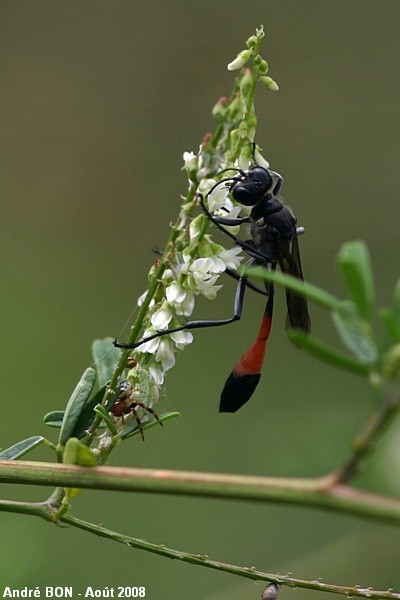
| Sand Digger Wasp (Ammophila sabulosa (Linnaeus, 1758)) |

|
|
Scientific name: Ammophila sabulosa (Linnaeus, 1758) Common name: Sand Digger Wasp Other names: Red-banded Sand Wasp French name: Ammophile des sables, Guêpe des sables Order: Hymenoptera Family: Sphecidae Wingspan : Females 20-28 mm, males 16-23 mm. Biotope: Hot and sandy places. Geographic area: All Europe, especially in the south. Observation period : May to October. |
The Sand Digger Wasp is a kind of lengthy wasp. The wings are short and dark. The legs are black. The first abdominal segment is very narrow and elongated. It is called petiole. The first abdominal segment and the base of the second one are black. The remaining part of the second segment and the third one are reddish. The tip of the abdomen is black with a blue sheen. You can observe adults on flowers where they feed on nectar. Each female digs about ten nests in the sandy ground. Each nest is made of a few centimetres long corridor leading to an incubation room. It catches non-hairy caterpillars is paralyses by pricking them with its dart. It pulls them into the nest, one or two per nest, and lay one egg on the caterpillar's body. Then it carefully closes the nest's hole. The larva feeds on the caterpillar and will pupate in the nest. More common species with a possible confusion with Sand Digger Wasps are: Ammophila heydeni which has red parts on the legs while the Sand Digger Wasp Ammophila sabulosa has completely black legs, and Ammophila campestris (also called Ammophila pubescens) which is a smaller size and has a reddish fourth abdominal segment (a closer examination of the third cubital cell on the wings also enables to tell both species apart - It is trapezoidal on Ammophila sabulosa, it is petiolate on Ammophila campestris). |
| [To know more about the Sand Digger Wasp] [Top] |

|
The size of this insect, the black legs and the almost black fourth abdominal segment make me think that this is one sand Digger Wasp. As I now know much more about this species, I will try, next time, to take a picture of the female pulling a caterpillar towards its nest. |